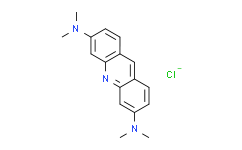


| 中文名称 |
Acridine Orange hydrochloride
|
|---|---|
| 中文别名 |
3,6-双(二甲基氨基)吖啶;3,6-双(二甲基氨基)吖啶盐酸盐;N,N,N',N'-四甲基-3,6-吖啶二胺单盐酸盐;吖啶橙;吖啶橙荧光素;盐酸吖啶橙;吖啶橙,盐酸盐水合物
|
| 英文名称 |
Acridine Orange hydrochloride
|
| 英文别名 |
3,6-Acridinediamine,N3,N3,N6,N6-tetramethyl-, hydrochloride (1:1);ACRIDINE ORANGE;Acridine Orange hydrochloride;ACRIDINE ORANGE HYDROCHLORIDE HYDRATE;Cellstain AO;acridineorangeno;acridineorangens;acridineoranger;Acridiniumorange-Kation;Acridin-orange;Acridinorangekation;BASIC ORANGE;EUCHRYSINE 3RX;RHODULINE ORANGE;Zamifenacin fumarate;3,6-Bis(dimethylamino)acridine hydrochloride;6-acridinediamine, n,n,n',n'-tetramethyl-monohydrochloride;acridine orange n;acridine orange no
|
| Cas No. |
65-61-2
|
| 分子式 |
C17H19N3.Cl-
|
| 分子量 |
300.81
|
| 包装储存 |
4°C, protect from light, stored under nitrogen *In solvent : -80°C, 6 months; -20°C, 1 month (protect from light, stored under nitrogen) |
| 详情描述 |
细胞和细胞器膜可透性核酸结合染料,Acridine orange 是与核酸结合的细胞渗透性荧光染料,导致光谱发射改变。
|
| 生物活性 |
Acridine Orange hydrochloride is a cell-penetrable nucleic acid-selective fluorescent dye. Acridine Orange hydrochloride produces orange fluorescence when it binds to ssDNA or RNA, and green fluorescence when it binds to dsDNA (Ex: 488 nM; Em: green fluorescence at 530 nm, orange fluorescence at 640 nm). |
|---|---|
| 性状 |
Solid |
| 体外研究(In Vitro) |
Guidelines (Following is our recommended protocol. This protocol only provides a guideline, and should be modified according to your specific needs). Medlife has not independently confirmed the accuracy of these methods. They are for reference only. |
| 体内研究(In Vivo) |
Acridine Orange hydrochloride (0.1 mg/kg,静脉注射,狗) 在 30 天内没有表现出临床毒性迹象,血液中也没有发现异常。 Medlife has not independently confirmed the accuracy of these methods. They are for reference only. |
| 运输条件 |
Room temperature or refrigerated transportation. |
| 储存方式 |
4°C, protect from light, stored under nitrogen *In solvent : -80°C, 6 months; -20°C, 1 month (protect from light, stored under nitrogen) |
| 染色示例 |
|
| Emission(Em) | |
| Excitation(Ex) | |
| 参考文献 |
|
| 溶解度数据 |
体外研究:
H2O : 50 mg/mL (165.67 mM; ultrasonic and heat to 60°C) DMSO : 25 mg/mL (82.83 mM; Need ultrasonic) 配制储备溶液
*
产品不同,其溶解度不同。建议根据产品选择合适的溶剂配制储备溶液;配成溶液后,建议分装保存,避免反复冻融造成的产品失效。 体内研究:
建议根据您的实验动物和给药方式选择适当的溶解方案。以下溶解方案都建议先按照 体外研究 方式配制澄清的储备液,再依次添加助溶剂:
——为保证实验结果的可靠性,澄清的储备液可以根据储存条件,适当保存;体内实验的工作液,建议您现用现配,当天使用;
以下溶剂前显示的百
*
|
|---|
[1]. McMaster GK, et al. Analysis of single- and double-stranded nucleic acids on polyacrylamide and agarosegels by using glyoxal and acridine orange. Proc Natl Acad Sci U S A. 1977 Nov;74(11):4835-8. [Information]
[2]. Traganos F, et al. Simultaneous staining of ribonucleic and deoxyribonucleic acids in unfixed cells using acridine orange in a flow cytofluorometric system. J Histochem Cytochem. 1977 Jan;25(1):46-56. [Information]
[3]. Byvaltsev VA, et al. Acridine Orange: A Review of Novel Applications for Surgical Cancer Imaging and Therapy. Front Oncol. 2019 Sep 24;9:925. [Information]
[4]. Wang Q, et al. Substrate stiffness regulates the differentiation profile and functions of osteoclasts via cytoskeletal arrangement. Cell Prolif. 2022 Jan;55(1):e13172. [Information]
1:一般建议:溶解度为Medlife测试数据,可能与文献描述存在差异。这是由于生产工艺和批次不同产生的正常现象。为了使其更好的溶解,请用37℃加热试管并在超声波水浴中震动片刻。不同批次产品溶解度各有差异,仅做参考,具体以实验方案为准。
2:储存条件:粉末-20°C一般情况可以保存3年,溶于溶剂-80°C一般情况可以保存1年。不同产品及不同批次产品可能存在差异,请细致阅读产品信息,并辅助参考相关文献描述。
Copyright © 2025 陌孚医药 All rights reserved 未经授权禁止拷贝本站所有资料,如有违反,将追究法律责任。
 沪ICP备2023012080号 |
沪ICP备2023012080号 |  沪公网安备31011402010657号
沪公网安备31011402010657号
 扫码关注公众号
扫码关注公众号
